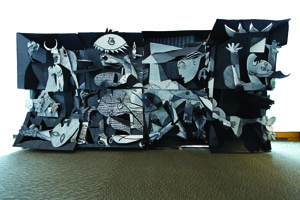Making Art: Picasso in 3-D (VIDEO)

Guided by popular art professor Logan Grider, eight first-year students reproduced a 3-D version of Picasso’s “Guernica.” Photo by Laurence Kesterson
On a rainy December afternoon, eight students heaved unwieldy 68-by-76-inch wood panels covered with cryptic 3-D shapes from Beardsley art studio to the lobby of the Eugene M. and Theresa Lang Performing Arts Center (LPAC). Assistant Professor of Art Logan Grider, who last year had students create a life-size 3-D reproduction of Thomas Eakins’ “The Gross Clinic,” was executing another creative coup. This time, though, he used Picasso’s “Guernica” as a model, asking each student in his first-year seminar Making Art to create one of eight sections of the originally two-dimensional painting. Their goal was to finally fit the sections together to form a full-size 3-D reproduction of the 25-by-11-foot original.
“The students had to interpret the physical space of the original painting, and there’s a lot of room for interpretation. It was up to the students to try and figure that out and then build and paint their cardboard shapes,” says Grider, who drew names from a hat to allocate the sections. “Certain areas are very puzzling and hard to make head or tail of. Even if you look at the original, it’s still overwhelming,” he adds.
Grider selected “Guernica” because of its powerful narrative, he says. Picasso completed the painting in a month in the middle of the Spanish Civil War in the 1930s. “We’ve been involved in some kind of war ever since any of these students were born. That’s really crazy,” he says.
On Dec. 23, the finished sections were brought to LPAC and assembled. Before the assembly date, the students didn’t know whether or not their renderings of the individual sections would align successfully. Despite having used no scaling device, they did align, and the result was stunning.
Says Dana Leonard ’16, “Logan’s assignments are always so creative. I learned so much from him this [fall]. This was a wonderful introduction to studio art at Swarthmore.”
 Email This Page
Email This Page